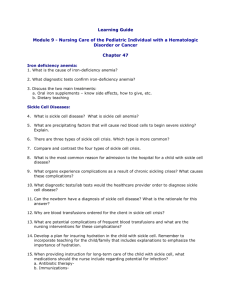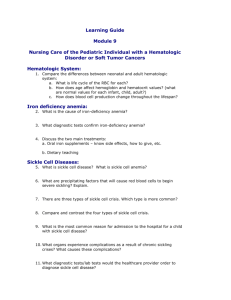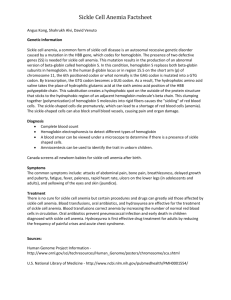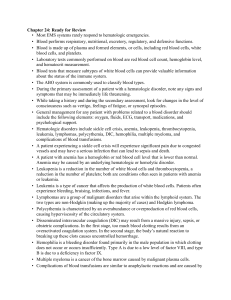Human Biology 11 – Dalesandro
advertisement
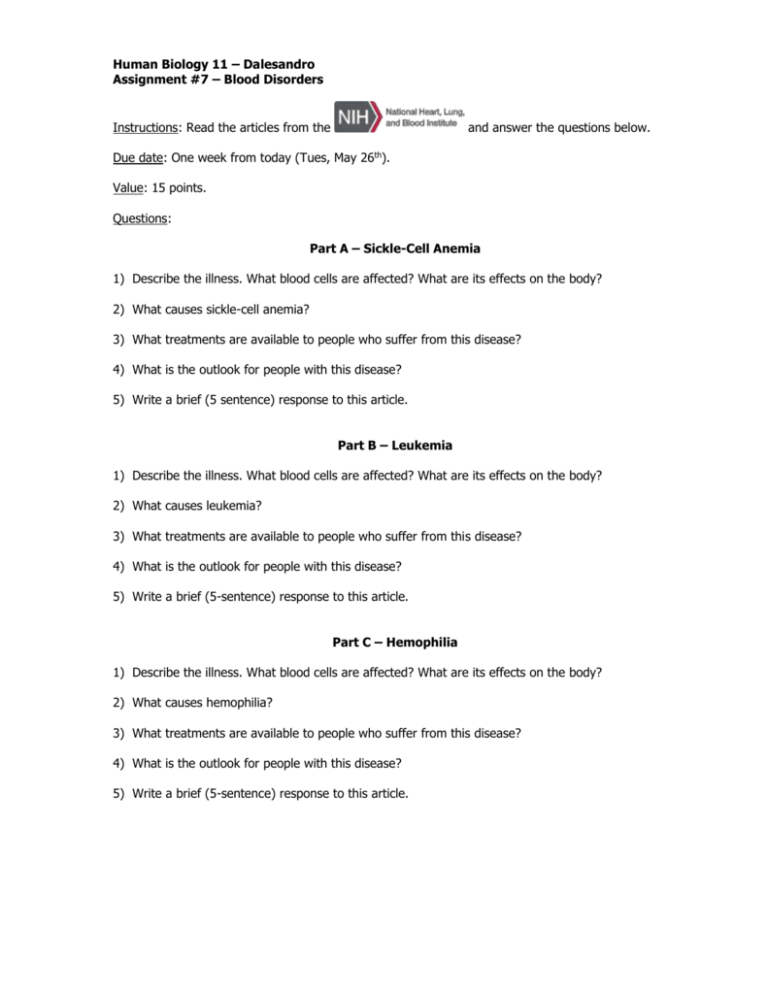
Human Biology 11 – Dalesandro Assignment #7 – Blood Disorders Instructions: Read the articles from the and answer the questions below. Due date: One week from today (Tues, May 26th). Value: 15 points. Questions: Part A – Sickle-Cell Anemia 1) Describe the illness. What blood cells are affected? What are its effects on the body? 2) What causes sickle-cell anemia? 3) What treatments are available to people who suffer from this disease? 4) What is the outlook for people with this disease? 5) Write a brief (5 sentence) response to this article. Part B – Leukemia 1) Describe the illness. What blood cells are affected? What are its effects on the body? 2) What causes leukemia? 3) What treatments are available to people who suffer from this disease? 4) What is the outlook for people with this disease? 5) Write a brief (5-sentence) response to this article. Part C – Hemophilia 1) Describe the illness. What blood cells are affected? What are its effects on the body? 2) What causes hemophilia? 3) What treatments are available to people who suffer from this disease? 4) What is the outlook for people with this disease? 5) Write a brief (5-sentence) response to this article. What Is Sickle Cell Anemia? Sickle cell anemia is the most common form of sickle cell disease (SCD). SCD is a serious disorder in which the body makes sickle-shaped red blood cells. “Sickle-shaped” means that the red blood cells are shaped like a crescent. Normal red blood cells are disc-shaped and look like donuts without holes in the center. They move easily through your blood vessels. Red blood cells contain an iron-rich protein called hemoglobin. This protein carries oxygen from the lungs to the rest of the body. Sickle cells contain abnormal hemoglobin called sickle hemoglobin or hemoglobin S. Sickle hemoglobin causes the cells to develop a sickle, or crescent, shape. Sickle cells are stiff and sticky. They tend to block blood flow in the blood vessels of the limbs and organs. Blocked blood flow can cause pain and organ damage. It can also raise the risk for infection. Figure A shows normal red blood cells flowing freely in a blood vessel. The inset image shows a crosssection of a normal red blood cell with normal hemoglobin. Figure B shows abnormal, sickled red blood cells blocking blood flow in a blood vessel. The inset image shows a cross-section of a sickle cell with abnormal (sickle) hemoglobin forming abnormal strands. Sickle cell anemia is one type of anemia. Anemia is a condition in which your blood has a lower than normal number of red blood cells. This condition also can occur if your red blood cells don't contain enough hemoglobin. Red blood cells are made in the spongy marrow inside the larger bones of the body. Bone marrow is always making new red blood cells to replace old ones. Normal red blood cells live about 120 days in the bloodstream and then die. They carry oxygen and remove carbon dioxide (a waste product) from your body. In sickle cell anemia, the abnormal sickle cells usually die after only about 10 to 20 days. The bone marrow can't make new red blood cells fast enough to replace the dying ones. Sickle cell anemia is an inherited, lifelong disease. People who have the disease are born with it. They inherit two genes for sickle hemoglobin—one from each parent. People who inherit a sickle hemoglobin gene from one parent and a normal gene from the other parent have a condition called sickle cell trait. Sickle cell trait is different than sickle cell anemia. People who have sickle cell trait don't have the disease. Like people who have sickle cell anemia, people who have sickle cell trait can pass the sickle hemoglobin gene to their children. Outlook Sickle cell anemia has no widely available cure. However, treatments to improve the anemia and lower complications can help with the symptoms and complications of the disease in both children and adults. Blood and marrow stem cell transplants may offer a cure for a small number of people. Over the past 100 years, doctors have learned a great deal about sickle cell anemia. They know its causes, how it affects the body, and how to treat many of its complications. Sickle cell anemia varies from person to person. Some people who have the disease have chronic (long-term) pain or fatigue (tiredness). However, with proper care and treatment, many people who have the disease can have improved quality of life and reasonable health much of the time. Because of improved treatments and care, people who have sickle cell anemia are now living into their forties or fifties, or longer. What Is Leukemia? Leukemia is an abnormal rise in the number of white blood cells. The white blood cells crowd out other blood cell elements such as red blood cells and platelets. The elevated white blood cells are immature and do not function properly. Leukemia -- the term derives from the Greek words for "white" and "blood" -- is often considered a disease of children, yet it actually affects far more adults. There will be more than 52,000 new patients diagnosed with all forms of leukemia in the United States in 2014 with about 24,000 deaths. Blood has three types of cells: white blood cells that fight infection, red blood cells that carry oxygen, and platelets that help blood to clot, all suspended in liquid plasma. Every day, hundreds of billions of new blood cells are produced in the bone marrow -- most of them red cells. In people with leukemia, however, the body starts producing more white cells than it needs. Many of the extra white cells do not mature normally, and they tend to live well beyond their normal life span. Despite their vast numbers, these leukemia cells are unable to fight infection the way normal white blood cells do. As they accumulate, they interfere with vital organ functions, including the production of healthy blood cells. Eventually, the body does not have enough red blood cells to supply oxygen, enough platelets to ensure proper clotting, or enough normal white blood cells to fight infection. This results in persons with leukemia being anemic as well as increasing their risks of bruising, bleeding, and infection. Causes No one knows exactly what causes leukemia. Certain genetic abnormalities have been associated with leukemia, but they do not cause it. Environmental factors also seem to influence the risk of developing leukemia. Tobacco smokers are more prone to leukemia. Research also suggests that prolonged exposure to radiation is associated with leukemia. Outlook There are many treatments available for leukemia. They include chemotherapy and stem cell transplantation. Some people receive a combination of treatments. There are many different kinds of leukemia. Some respond well to treatment and can be cured in some cases, while others are more difficult to treat. Treatment for leukemia can often control the disease and its symptoms, but it can seldom cure the disease. However, there are several treatments now available for leukemia that can control the disease for a long time, including chemotherapy and gene therapy. What is Hemophilia? Hemophilia is a rare bleeding disorder in which the blood doesn't clot normally. If you have hemophilia, you may bleed for a longer time than others after an injury. You also may bleed inside your body (internally), especially in your knees, ankles, and elbows. This bleeding can damage your organs and tissues and may be life threatening. Overview Hemophilia usually is inherited. The disorder is passed from parents to children through genes. It is potentially life-threatening. People born with hemophilia have little or no clotting factor. Clotting factor is a protein needed for normal blood clotting this protein is associated with platelets and helps the blood stop flowing at the site of an injury. Platelets are small blood cells that form in the bone marrow—sponge-like tissue in the bones. Platelets play a major role in blood clotting. When blood vessels are injured, clotting factor helps platelets stick together to plug cuts and breaks on the vessels and stop bleeding. Sometimes, people aren't born with the disorder, but they develop it during their lifetime. This can happen if your own body’s immune system attacks the clotting factor or platelets in your bloodstream. This can prevent the clotting factor and/or platelets from doing their job. Symptoms The major signs and symptoms of hemophilia are excessive bleeding and easy bruising. The extent of bleeding depends on how severe the hemophilia is. People who have mild hemophilia may not have signs unless they have excessive bleeding from a dental procedure, an accident, or surgery. Bruising is bleeding that occurs inside the body. People with hemophilia bruise easily. Outlook Hemophilia can be mild, moderate, or severe, depending on how much clotting factor and/or platelets are left in your blood. About 70% of people who have hemophilia have the severe form of the disorder. Hemophilia usually occurs in men. About 1 in 5,000 males are born with hemophilia each year. Rarely, a woman can be born with or develop hemophilia. There is no cure for hemophilia, but treatment can help preserve clotting factor and platelets, or cause new clotting factor and platelets to be made by the body.

